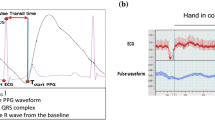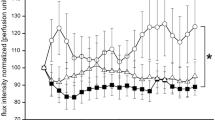Abstract
Autonomic dysfunction in multiple system atrophy (MSA) comprises cardinal symptoms of orthostatic hypotension (OH) and urinary incontinence. Additionally, cardiovagal and sudomotor abnormalities can be present. Previous studies compared hand skin temperature and its response to cooling in subjects with probable MSA and Parkinson’s disease (PD). Significant differences were found indicating that disturbed thermoregulation belongs to MSA autonomic features and could be helpful in differentiation of MSA from PD. The objective of this study was to improve our knowledge about impaired thermoregulation of distal extremities in MSA with parkinsonian features (MSA-P) and PD and to assess the possible interrelations for the different subtypes of autonomic dysfunction in a large cohort of MSA-P, PD and control patients. The patients underwent a standard cooling—rewarming procedure, termed ice test (IT). Electroneurography, heart rate variability, sympathetic skin response and orthostatic tests were performed for the subdivision of the patients. The prevalence of pathological IT was slightly increased in MSA compared with PD and control groups. The presence of pathological IT was related with older patient’s age in PD and control groups significantly (p < 0.05). This relation was absent for the MSA patients, who themselves were significantly younger (p = 0.001). Significant association between the presence of pathological IT and OH was determined (p < 0.001). Defective thermoregulation of distal extremities seems to be more severe in the MSA patients. The dysfunction of preganglionic sympathetic neurons might be involved in impaired response to cooling for MSA. The results suggest pathophysiological affinity of impaired sympathetic neurovascular regulation between pathological IT and OH.

Similar content being viewed by others
References
Chung EJ, Lee WY, Yoon WT, Kim BJ, Lee GH (2009) MIBG scintigraphy for differentiating Parkinson’s disease with autonomic dysfunction from Parkinsonism-predominant multiple system atrophy. Mov Disord 24(11):1650–1655
Cossu G, Melis M (2016) The peripheral nerve involvement in Parkinson Disease: a multifaceted phenomenon. Parkinsonism Relat Disord 25:17–20
De Marinis M, Stocchi F, Gregori B, Accornero N (2000) Sympathetic skin response and cardiovascular autonomic function tests in Parkinson’s disease and multiple system atrophy with autonomic failure. Mov Disord 15(6):1215–1220
Doppler K, Weis J, Karl K, Ebert S, Ebentheuer J, Trenkwalder C, Klebe S, Volkmann J, Sommer C (2015) Distinctive distribution of misfolded alpha-synuclein in dermal nerves in multiple system atrophy. Mov Disord 30(12):1688–1692
Fanciulli A, Wenning GK (2015) Multiple-system atrophy. N Engl J Med 372(14):1375–1376
Freeman R, Wieling W, Axelrod FB et al (2011) Consensus statement on the definition of orthostatic hypotension, neurally mediated syncope and the postural tachycardia syndrome. Auton Neurosci 161(1–2):46–48
Gilman S, Wenning GK, Low PA et al (2008) Second consensus statement on the diagnosis of multiple system atrophy. Neurology 71(9):670–676
Haapaniemi TH, Korpelainen JT, Tolonen U, Suominen K, Sotaniemi KA, Myllylä VV (2000) Suppressed sympathetic skin response in Parkinson disease. Clin Auton Res 10(6):337–342
Hughes AJ, Daniel SE, Kilford L, Lees AJ (1992) Accuracy of the clinical diagnosis of idiopathic Parkinson’s disease: a clinico-pathological study of 100 cases. J Neurol Neurosurg Psychiatry 55:181–184
Iodice V, Lipp A, Ahlskog JE et al (2012) Autopsy confirmed multiple system atrophy cases: Mayo experience and role of autonomic function tests. J Neurol Neurosurg Psychiatry 83(4):453–459
Jellinger KA, Wenning GK (2016) Multiple system atrophy: pathogenic mechanisms and biomarkers. J Neural Transm (Vienna) 123(6):555–572
Jost WH (2013) Urological problems in Parkinson’s disease: clinical aspects. J Neural Transm (Vienna) 120(4):587–591
Jost WH, Augustis S (2015) Severity of orthostatic hypotension in the course of Parkinson’s disease: no correlation with the duration of the disease. Parkinsonism Relat Disord 21(3):314–316
Jost WH, Del Tredici K, Landvogt C, Braune S (2010) Importance of 123I-metaiodobenzylguanidin (MIBG) scintigraphy/SPECT for diagnosis and deferential diagnostics of Parkinson syndromes. Neurodegener Dis 7:341–347
Kimpinski K, Iodice V, Burton DD, Camilleri M, Mullan BP, Lipp A, Sandroni P, Gehrking TL, Sletten DM, Ahlskog JE, Fealey RD, Singer W, Low PA (2012) The role of autonomic testing in the differentiation of Parkinson’s disease from multiple system atrophy. J Neurol Sci 317(1–2):92–96
Klein C, Brown R, Wenning G, Quinn N (1997) The “cold hands sign” in multiple system atrophy. Mov Disord 12(4):514–518
Koga S, Aoki N, Uitti RJ et al (2015) When DLB, PD, and PSP masquerade as MSA: an autopsy study of 134 patients. Neurology 85(5):404–412
Lipp A, Sandroni P, Ahlskog JE, Fealey RD, Kimpinski K, Iodice V, Gehrking TL, Weigand SD, Sletten DM, Gehrking JA, Nickander KK, Singer W, Maraganore DM, Gilman S, Wenning GK, Shults CW, Low PA (2009a) Prospective differentiation of multiple system atrophy from Parkinson disease, with and without autonomic failure. Arch Neurol 66(6):742–750. doi:10.1001/archneurol.2009.71
Lipp A, Sandroni P, Low PA (2009b) Systemic postganglionic adrenergic studies do not distinguish Parkinson’s disease from multiple system atrophy. J Neurol Sci 281(1–2):15–19. doi:10.1016/j.jns.2009.03.006
Pietzarka K, Reimann M, Schmidt C et al (2010) The cold hand sign in multiple system atrophy: skin perfusion revisited. J Neural Transm (Vienna) 117(4):475–479
Shahani BT, Day TJ, Cros D, Khalil N, Kneebone CS (1990) RR interval variation and the sympathetic skin response in the assessment of autonomic function in peripheral neuropathy. Arch Neurol 47(6):659–664
Sun Z, Jia D, Shi Y et al (2016) Prediction of orthostatic hypotension in multiple system atrophy and Parkinson disease. Sci Rep 6:2164–2169
Taylor LJ, Harris J, Epps CD, Herr K (2005) Psychometric evaluation of selected pain intensity scales for use with cognitively impaired and cognitively intact older adults. Rehabil Nurs 30(2):55–61
Trojanowski JQ, Revesz T (2007) Proposed neuropathological criteria for the post mortem diagnosis of multiple system atrophy. Neuropathol Appl Neurobiol 33:615–620
Wenning GK, Granata R, Krismer F et al (2012) Orthostatic hypotension is differentially associated with the cerebellar versus the parkinsonian variant of multiple system atrophy: a comparative study. Cerebellum 11(1):223–226
Acknowledgements
We thank Ms. Tanja Fiesel for a kind assistance in the collection of data.
Author information
Authors and Affiliations
Corresponding author
Ethics declarations
Conflict of interest
The authors declare that they have no conflict of interest.
This is a retrospective study; for this type of study, formal consent is not required.
Rights and permissions
About this article
Cite this article
Augustis, S., Saferis, V. & Jost, W.H. Autonomic disturbances including impaired hand thermoregulation in multiple system atrophy and Parkinson’s disease. J Neural Transm 124, 965–972 (2017). https://doi.org/10.1007/s00702-016-1665-8
Received:
Accepted:
Published:
Issue Date:
DOI: https://doi.org/10.1007/s00702-016-1665-8




